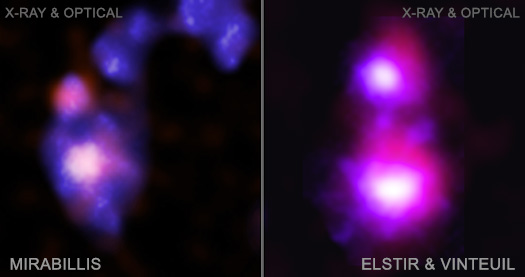A new study using NASA’s Chandra X-ray Observatory has tracked two pairs of supermassive black holes in dwarf galaxies on collision courses, as discussed in our latest press release. This is the first evidence for such an impending encounter, providing scientists with important information about the growth of black holes in the early Universe.
By definition, dwarf galaxies contain stars with a total mass less than 3 billion Suns — or about 20 times less than the Milky Way. Astronomers have long suspected that dwarf galaxies merge, particularly in the relatively early Universe, in order to grow into the larger galaxies seen today. However, current technology cannot observe the first generation of dwarf galaxy mergers because they are extraordinarily faint at their great distances. Another tactic — looking for dwarf galaxy mergers closer by — had not been successful to date.
The new study overcame these challenges by implementing a systematic survey of deep Chandra X-ray observations and comparing them with infrared data from NASA’s Wide Infrared Survey Explorer (WISE) and optical data from the Canada-France-Hawaii Telescope (CFHT).
Chandra was particularly valuable for this study because material surrounding black holes can be heated up to millions of degrees, producing large amounts of X-rays. The team searched for pairs of bright X-ray sources in colliding dwarf galaxies as evidence of two black holes, and discovered two examples.
One pair is in the galaxy cluster Abell 133 located 760 million light-years from Earth, seen in the composite image on the left. Chandra X-ray data is in pink and optical data from CFHT is in blue. This pair of dwarf galaxies appears to be in the late stages of a merger, and shows a long tail caused by tidal effects from the collision. The authors of the new study have nicknamed it “Mirabilis” after an endangered species of hummingbird known for their exceptionally long tails. Only one name was chosen because the merger of two galaxies into one is almost complete. The two Chandra sources show X-rays from material around the black holes in each galaxy.

The other pair was discovered in Abell 1758S, a galaxy cluster about 3.2 billion light-years away. The composite image from Chandra and CFHT is on the right, using the same colors as for Mirabilis. The researchers nicknamed the merging dwarf galaxies “Elstir” and “Vinteuil,” after fictional artists from Marcel Proust's "In Search of Lost Time". Vinteuil is the galaxy on the top and Elstir is the galaxy on the bottom. Both have Chandra sources associated with them, again from X-rays from material around the black holes in each galaxy. The researchers think these two have been caught in the early stages of a merger, causing a bridge of stars and gas to connect the two colliding galaxies from their gravitational interaction.
The details of merging black holes and dwarf galaxies may provide insight to our Milky Way’s own past. Scientists think nearly all galaxies began as dwarf or other types of small galaxies and grew over billions of years through mergers. Follow-up observations of these two systems will allow astronomers to study processes that are crucial for understanding galaxies and their black holes in the earliest stages of the Universe.
A paper describing these results is being published in the latest issue of The Astrophysical Journal and a preprint is available here. The authors of the study are Marko Micic, Olivia Holmes, Brenna Wells, and Jimmy Irwin, all from the University of Alabama at Tuscaloosa.
NASA's Marshall Space Flight Center manages the Chandra program. The Smithsonian Astrophysical Observatory's Chandra X-ray Center controls science operations from Cambridge, Massachusetts, and flight operations from Burlington, Massachusetts.
This release includes two composite images presented side by side, separated by a thin white line. The image on our left features two colliding dwarf galaxies in the late stages of merging into one larger galaxy. The image on our right features two colliding dwarf galaxies in the early stages of merging.
In the first pair of dwarf galaxies, on our left, a pale pink shape sits inside a hazy indigo blue cloud. The cloud contains neon pink streaks, and faint white specks. This cloud represents gas and stars in the merging galaxies. The pale pink shape at its core represents a black hole being tracked by the Chandra X-ray Observatory. Directly above the cloud is a neon pink and indigo circle, representing another black hole, followed by a curving tail of hazy indigo circles flecked with white. This tail, which curves up and to our right, is caused by tidal effects from the ongoing collision. Because these two dwarf galaxies are in the final stages of merging, scientists have given the combined galaxy a single name: Mirabilis.
In the second pair of dwarf galaxies, on our right, a neon pink cloud with a bright white circle at its core, sits above a larger companion with the same color configuration. These pink clouds are the dwarf galaxies known as Vinteuil and Elstir. The white cores represent black holes tracked by Chandra. Elstir, the larger neon pink cloud, near the bottom, features wispy tendrils. Several of these tendrils appear to reach up toward the smaller galaxy, Vinteuil, creating a bridge of gas and stars.
|
||||||||||||||||||||||||||||||
|
||||||||||||||||||||||||||||||


